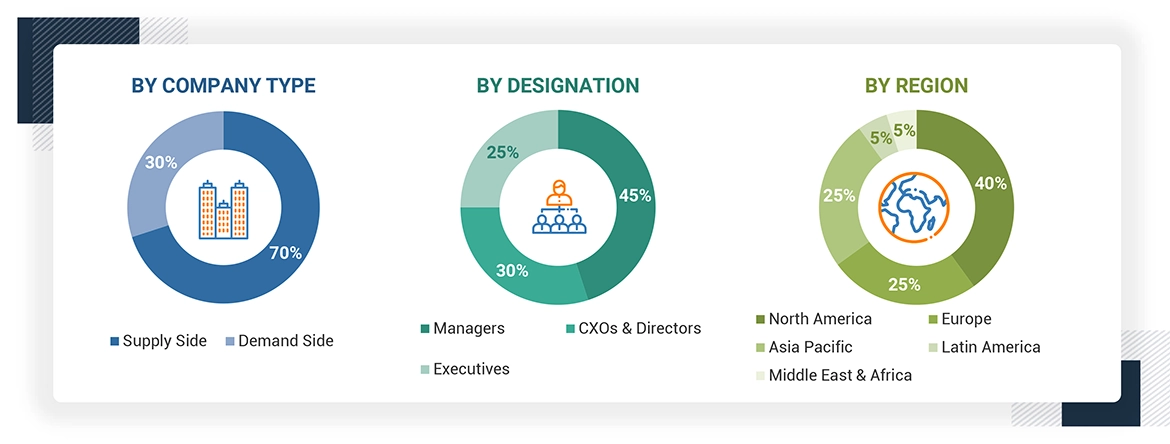This research study includes significant use of secondary sources, directories, and databases to discover and collect valuable information for analyzing the global bioconjugation market. In-depth interviews were conducted with a variety of primary respondents, including key industry participants, subject-matter experts (SMEs), C-level executives of key market players, and industry consultants, to gather and verify critical qualitative and quantitative data and assess the market's growth prospects. The global market size determined from secondary research was then triangulated with primary research inputs to calculate the final market size.
Secondary Research
Secondary research was used mainly to identify and collect information for the extensive, technical, market-oriented, and commercial study of the bioconjugation market. The secondary sources used for this study include World Health Organization (WHO), the National Institutes of Health (NIH), the United States Food and Drug Administration (US FDA), American Chemical Society (ACS), Royal Society of Chemistry, American Society of Clinical Oncology (ASCO), American Association for Cancer Research (AACR), Antibody Society, Biotechnology Innovation Organization (BIO), ADC Review, Journal of Antibody-drug Conjugates, Center of Disease Control & Prevention (CDC), National Center for Biotechnology Information (NCBI), EvalutePharma, ScienceDirect, Eurostat, and Factiva; corporate filings such as annual reports, SEC filings, investor presentations, and financial statements; press releases; trade, business, professional associations and among others. These sources were also used to obtain key information about major players, market classification, and segmentation according to industry trends, regional/country-level markets, market developments, and technology perspectives.
Primary Research
Extensive primary research was conducted after acquiring basic knowledge about the global bioconjugation market scenario through secondary research. Several primary interviews were conducted with market experts from the demand side, such as pharmaceutical & biotechnology companies, academic & research institutes, hospitals & clinical/diagnostic laboratories, CROs, and CMOs, and experts from the supply side, such as C-level and D-level executives, product managers, marketing & sales managers of key manufacturers, distributors, and channel partners. These interviews were done in five key regions: Asia Pacific, North America, Europe, Latin America, and Middle East & Africa. About 70% and 30% of the primary interviews were conducted with supply-side and demand-side participants, respectively. This data was gathered using questionnaires, e-mails, online surveys, in-person interviews, and telephone interviews.
The following is a breakdown of the primary respondents:

To know about the assumptions considered for the study, download the pdf brochure
Market Size Estimation
Both top-down and bottom-up approaches were used to estimate and validate the total size of the bioconjugation market. These methods were also used extensively to estimate the size of various subsegments in the market. The research methodology used to estimate the market size includes the following:
Data Triangulation
After arriving at the market size from the market size estimation process explained above, the total market was divided into several segments and subsegments. To complete the overall market engineering process and arrive at the exact statistics for all segments and subsegments, data triangulation and market breakdown procedures were employed, wherever applicable. The data was triangulated by studying various factors and trends from both the demand and supply sides.
Market Definition
Bioconjugation refers to the chemical or biological process of forming a stable covalent bond between two molecules, typically involving a biomolecule (such as a protein, antibody, nucleic acid, or peptide) and another molecule, which could be a drug, imaging agent, polymer, or another biomolecule_ The purpose of bioconjugation is to combine the properties of the two molecules, creating a single functional entity with enhanced or novel capabilities.
The report presents the market size for bioconjugation services and products that can be utilized throughout the bioconjugation process, from preparation to analysis. The key segments of the market include products such as consumables, & instruments, along with services for bioconjugation.
Stakeholders
-
Bioconjugation Product Manufacturers
-
Distributors of Bioconjugation Products
-
Bioconjugation Service Providers
-
Biotechnology, Biopharmaceutical, and Pharmaceutical Companies
-
Research Institutes and Clinical Research Organizations (CROs)
-
Contract Manufacturing Organizations (CMOs)
-
Academic Institutes
-
Investors
-
Medical Institutes & Universities
-
Venture Capitalists
-
Insurance Providers
-
Government Bodies
Report Objectives
-
To define, describe, and forecast the global bioconjugation products market based on type, technique, biomolecule type application, end user, and region
-
To define, describe, and forecast the global bioconjugation services market based on type, technique, conjugation type application, end user, and region
-
To provide detailed information regarding the major factors influencing the market growth (drivers, restraints, opportunities, and challenges)
-
To strategically analyze micromarkets1 with respect to their individual growth trends, future prospects, and contributions to the total market
-
To analyze opportunities in the market for stakeholders and provide details of the competitive landscape for market leaders
-
To forecast the revenue of the market segments with respect to six major regions:
-
North America, Europe, Asia Pacific, Latin America, the Middle East, and Africa
-
To profile the key players and comprehensively analyze their market shares and core competencies
-
To track and analyze competitive developments such as product/service launches, agreements, partnerships, collaborations, acquisitions, and expansions in the bioconjugation market
-
To benchmark players within the bioconjugation market using the Company Evaluation Matrix framework, which analyzes market players based on various parameters within the broad categories of business and product/service strategy



Growth opportunities and latent adjacency in Bioconjugation Market